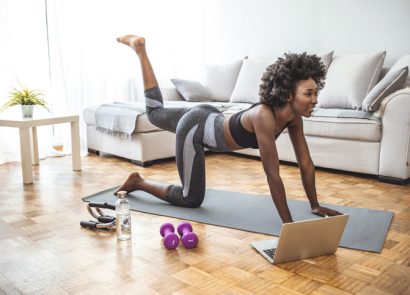You’ve been bashing out the same routine at the gym for months, if not years – it’s no wonder your body isn’t responding any more! When you feel as though your fitness has reached a plateau, when you’re not losing weight or feeling extra tightness, motivation will spiral and you’ll hit a slump. There’s only one thing for it – you need to step up your game, and work it much harder.
PT Ross Styles (rossstyles. com) says that sometimes you need to change your workout completely, even if it is just for a week. “Your body adapts and gets used to the same stimulus, so unless you are continually adding extra weights and changing what you do, you’ll never improve on fitness or weightloss goals.” Want to turn up your workout intensity? Here’s how…
Intervals (with a difference)
Ross recommends adding some ‘interval opposites’ where instead of resting in between sets, like you do in normal interval training, you add an exercise that uses the opposite muscles. Ross explains, “Push-ups followed by lunges, for example, are a fantastic way to make the workout more efficient, and although this allows your muscles to recover for the next set, you are not actually resting, keeping your heart rate up constantly.” Working your upper body followed by your lower, is more intense, Ross explains, “This is because the oxygenated blood has to travel further in a shorter period of time.”
Ten on, ten off
Osteopath and PT Tamir Grant (tgrantwellbeing.com) has devised his own interval training that suits his clients whatever level they’re working at. Tamir says, “The thing I am asked most by clients is how they can ensure a high-intensity workout doesn’t damage joints and muscles. As spinning and other interval-based classes are more popular than ever, I have devised my own method called ‘ten plus ten’. They work for ten seconds, then have ten seconds off.”
Tamir says in the rest time it’s important the person thinks about how their muscles and joints are feeling: “When you’re in the throes of a high intensity workout, it’s very hard to listen to your body. These very brief rest periods allow for this reflection and therefore reduce the risk of injury.
“As this technique is about listening to your body, it is doable and achievable for all my clients. This can be done with planks, skipping or boxing, running on the spot, pushing yourself to work as hard as possible. I use a ten second beeper for added motivation.”
HIIT & tone
You’ll probably have heard of high intensity interval training (HIIT), which normally involves high intensity sections, followed by rests, often 30 seconds of each, then repeated. However the concept of HIIT & Tone takes it to a new level. Ross tells us how it works: “Basically, it adds in a toning section alternated with the cardio. However these are lower intensity exercises that normally focus on toning body parts rather than cardio activities. This gives you more bang for your buck and is a great way to burn fat and tone up fast for a deadline, like before Christmas or a holiday.”}




















